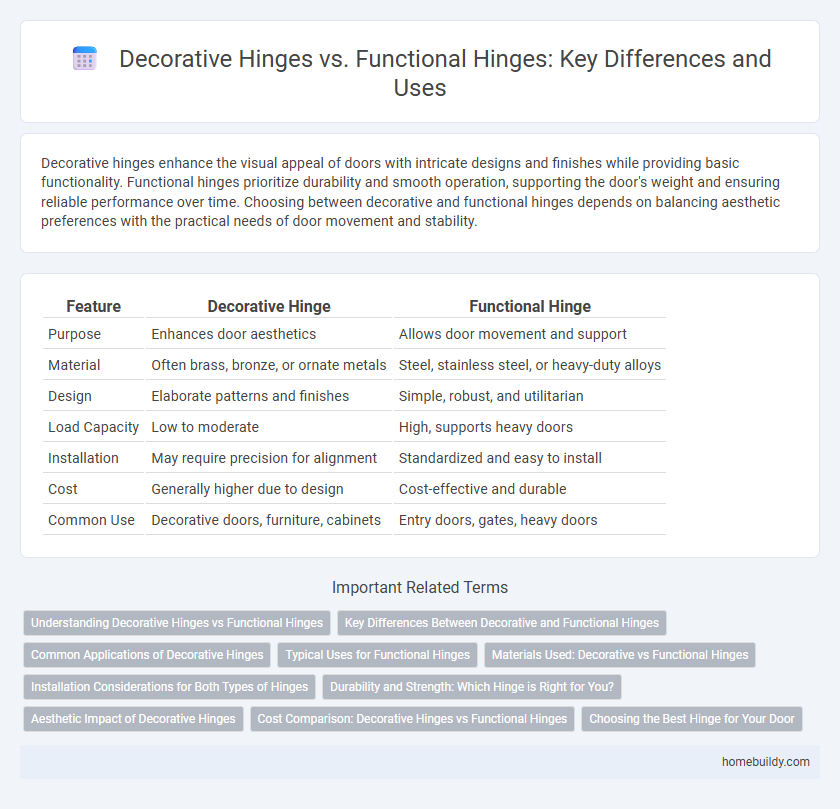Decorative hinges enhance the visual appeal of doors with intricate designs and finishes while providing basic functionality. Functional hinges prioritize durability and smooth operation, supporting the door's weight and ensuring reliable performance over time. Choosing between decorative and functional hinges depends on balancing aesthetic preferences with the practical needs of door movement and stability.
Table of Comparison
| Feature | Decorative Hinge | Functional Hinge |
|---|---|---|
| Purpose | Enhances door aesthetics | Allows door movement and support |
| Material | Often brass, bronze, or ornate metals | Steel, stainless steel, or heavy-duty alloys |
| Design | Elaborate patterns and finishes | Simple, robust, and utilitarian |
| Load Capacity | Low to moderate | High, supports heavy doors |
| Installation | May require precision for alignment | Standardized and easy to install |
| Cost | Generally higher due to design | Cost-effective and durable |
| Common Use | Decorative doors, furniture, cabinets | Entry doors, gates, heavy doors |
Understanding Decorative Hinges vs Functional Hinges
Decorative hinges enhance the aesthetic appeal of doors with intricate designs, unique finishes, and artistic craftsmanship, making them ideal for settings where style is a priority. Functional hinges prioritize durability, load-bearing capacity, and smooth operation to ensure the door's movement is reliable and secure, often used in high-traffic or heavy-door applications. Selecting between decorative and functional hinges depends on balancing visual impact with mechanical performance requirements.
Key Differences Between Decorative and Functional Hinges
Decorative hinges primarily enhance the aesthetic appeal of doors with intricate designs and finishes, while functional hinges focus on durability and smooth operation to support door movement. Functional hinges are typically made from robust materials like steel or brass to withstand frequent use, whereas decorative hinges may use lighter or ornamental materials that emphasize style over strength. The key differences lie in their intended purpose, material composition, load-bearing capacity, and impact on door performance.
Common Applications of Decorative Hinges
Decorative hinges are commonly applied in cabinetry, furniture, and interior doors where aesthetic appeal enhances design, often featuring intricate patterns and finishes like antique brass, oil-rubbed bronze, or polished nickel. These hinges serve both as hardware and ornamental elements, making them ideal for period-style cabinetry, garden gates, and custom-made furniture to complement the overall decor. Unlike functional hinges primarily engineered for strength and durability in heavy doors or industrial settings, decorative hinges balance form and function, prioritizing visual impact alongside adequate support.
Typical Uses for Functional Hinges
Functional hinges are primarily used in applications requiring durability and strength, such as doors, cabinets, and gates, where reliable movement and weight support are critical. These hinges are designed to withstand frequent use and heavy loads, making them ideal for exterior doors, industrial machinery, and security enclosures. Unlike decorative hinges, functional hinges prioritize performance over aesthetics, ensuring smooth operation and long-lasting functionality in everyday applications.
Materials Used: Decorative vs Functional Hinges
Decorative hinges often feature materials such as brass, bronze, or stainless steel with polished or antique finishes to enhance aesthetic appeal, while functional hinges prioritize durability and strength with materials like heavy-duty steel or wrought iron. Decorative hinges may incorporate intricate designs and plating for corrosion resistance, whereas functional hinges focus on robust construction and wear-resistant coatings for long-term performance. Selection depends on balancing the need for visual enhancement against mechanical reliability based on door usage and environmental exposure.
Installation Considerations for Both Types of Hinges
Decorative hinges often require precise alignment and surface preparation to showcase their aesthetic appeal without compromising door operation, typically needing screws that match the finish for a seamless look. Functional hinges prioritize durability and smooth movement, so installation involves ensuring robust screw anchoring into the door frame and door edge, as well as correct positioning to support the door's weight and prevent sagging. Both types demand careful measurement and level placement, but decorative hinges may require additional attention to detail to integrate design elements while maintaining structural integrity.
Durability and Strength: Which Hinge is Right for You?
Decorative hinges prioritize aesthetics with intricate designs and finishes but often compromise on durability and strength compared to functional hinges engineered for heavy-duty performance. Functional hinges are typically made from robust materials like stainless steel or brass, offering superior load-bearing capacity and resistance to wear and tear over time. For applications requiring long-lasting support and stability, such as exterior doors or heavy gates, functional hinges are the optimal choice, while decorative hinges suit interior doors where visual appeal is more important than structural strength.
Aesthetic Impact of Decorative Hinges
Decorative hinges enhance the visual appeal of doors by featuring intricate designs, unique finishes, and ornamental shapes that contribute to the overall interior decor. Unlike functional hinges that prioritize durability and smooth operation, decorative hinges serve as a key element in architectural style, often crafted from materials like brass or bronze to complement traditional or vintage aesthetics. The aesthetic impact of decorative hinges can transform ordinary doors into focal points, adding character and elegance to residential or commercial spaces.
Cost Comparison: Decorative Hinges vs Functional Hinges
Decorative hinges typically cost more due to intricate designs and premium materials, enhancing aesthetic appeal while serving as functional hardware. Functional hinges prioritize durability and load-bearing capacity, often made from standard metals at a lower price point. Choosing between decorative and functional hinges depends on balancing budget constraints with design preferences and intended usage.
Choosing the Best Hinge for Your Door
Choosing the best door hinge depends on balancing aesthetics and functionality; decorative hinges offer intricate designs that enhance door appearance but may compromise durability under heavy use. Functional hinges prioritize strength and smooth operation, ideal for frequently used doors or heavy materials, ensuring long-lasting performance. Consider the door type, weight, and frequency of use to select a hinge that meets both decorative appeal and practical requirements effectively.
decorative hinge vs functional hinge Infographic

 homebuildy.com
homebuildy.com